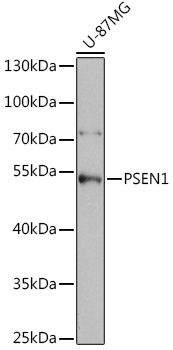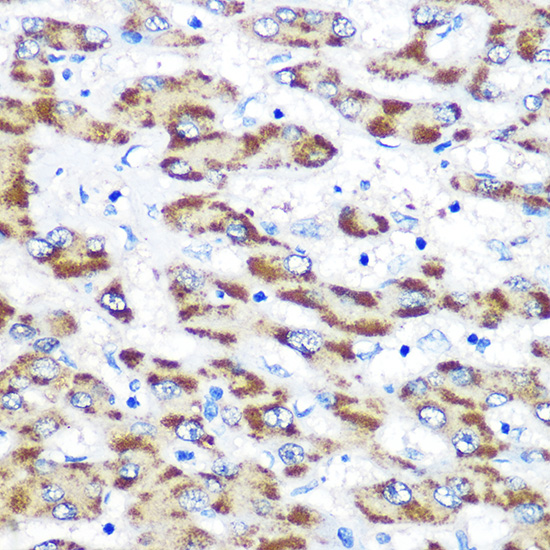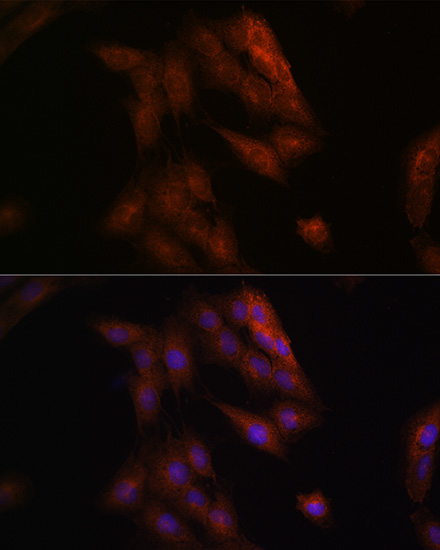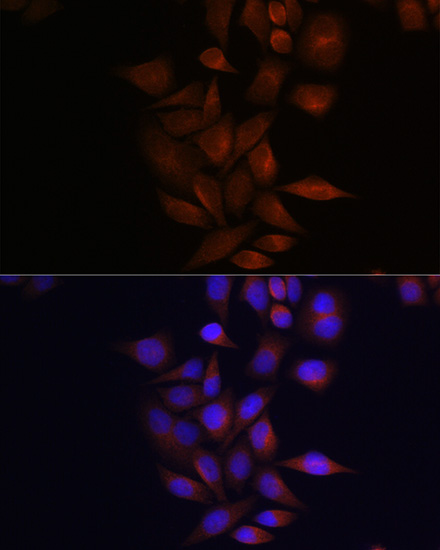Anti-PSEN1 Antibody (CAB2187)
- SKU:
- CAB2187
- Product type:
- Antibody
- Reactivity:
- Human
- Mouse
- Rat
- Host Species:
- Rabbit
- Isotype:
- IgG
- Research Area:
- Cell Death
Description
| Antibody Name: | Anti-PSEN1 Antibody |
| Antibody SKU: | CAB2187 |
| Antibody Size: | 20uL, 50uL, 100uL |
| Application: | WB IHC IF |
| Reactivity: | Human, Mouse, Rat |
| Host Species: | Rabbit |
| Immunogen: | Recombinant fusion protein containing a sequence corresponding to amino acids 1-160 of human PSEN1 (NP_015557.2). |
| Application: | WB IHC IF |
| Recommended Dilution: | WB 1:500 - 1:2000 IHC 1:50 - 1:200 IF 1:50 - 1:200 |
| Reactivity: | Human, Mouse, Rat |
| Positive Samples: | U-87MG |
| Immunogen: | Recombinant fusion protein containing a sequence corresponding to amino acids 1-160 of human PSEN1 (NP_015557.2). |
| Purification Method: | Affinity purification |
| Storage Buffer: | Store at -20°C. Avoid freeze / thaw cycles. Buffer: PBS with 0.02% sodium azide, 50% glycerol, pH7.3. |
| Isotype: | IgG |
| Sequence: | MTEL PAPL SYFQ NAQM SEDN HLSN TNDN RERQ EHND RRSL GHPE PLSN GRPQ GNSR QVVE QDEE EDEE LTLK YGAK HVIM LFVP VTLC MVVV VATI KSVS FYTR KDGQ LIYT PFTE DTET VGQR ALHS ILNA AIMI SVIV VMTI LLVV LYKY RCYK VIHA |
| Gene ID: | 5663 |
| Uniprot: | P49768 |
| Cellular Location: | Cell membrane, Cell surface, Endoplasmic reticulum membrane, Golgi apparatus membrane, Multi-pass membrane protein |
| Calculated MW: | 21kDa/42kDa/46kDa/48kDa/52kDa |
| Observed MW: | 52kDa |
| Synonyms: | AD3, FAD, PS-1, PS1, S182, Presenilin 1, PSEN1 |
| Background: | Alzheimer's disease (AD) patients with an inherited form of the disease carry mutations in the presenilin proteins (PSEN1; PSEN2) or in the amyloid precursor protein (APP). These disease-linked mutations result in increased production of the longer form of amyloid-beta (main component of amyloid deposits found in AD brains). Presenilins are postulated to regulate APP processing through their effects on gamma-secretase, an enzyme that cleaves APP. Also, it is thought that the presenilins are involved in the cleavage of the Notch receptor, such that they either directly regulate gamma-secretase activity or themselves are protease enzymes. Several alternatively spliced transcript variants encoding different isoforms have been identified for this gene, the full-length nature of only some have been determined. |
| UniProt Protein Function: | PSEN1: probable catalytic subunit of the gamma-secretase complex, an endoprotease complex that catalyzes the intramembrane cleavage of integral membrane proteins such as Notch receptors and APP (beta-amyloid precursor protein). Requires the other members of the gamma-secretase complex to have a protease activity. May play a role in intracellular signaling and gene expression or in linking chromatin to the nuclear membrane. Regulates epithelial- cadherin function. Five alternative splice isoforms have been identified. |
| UniProt Protein Details: | Protein type:Cell surface; Protease; Mitochondrial; Membrane protein, integral; Membrane protein, multi-pass; EC 3.4.23.- Chromosomal Location of Human Ortholog: 14q24.3 Cellular Component: Golgi apparatus; nuclear outer membrane; centrosome; cell surface; smooth endoplasmic reticulum; mitochondrion; lysosomal membrane; integral to plasma membrane; integral to membrane; lipid raft; ciliary rootlet; kinetochore; cell soma; membrane; perinuclear region of cytoplasm; mitochondrial inner membrane; apical plasma membrane; cytoplasmic vesicle; dendritic shaft; neuromuscular junction; endoplasmic reticulum membrane; nuclear membrane; rough endoplasmic reticulum; endoplasmic reticulum; cell cortex; Z disc; Golgi membrane; growth cone; axon Molecular Function:protein binding; cadherin binding; calcium channel activity; endopeptidase activity; beta-catenin binding; aspartic-type endopeptidase activity; PDZ domain binding Biological Process: positive regulation of catalytic activity; extracellular matrix organization and biogenesis; activation of MAPKK activity; positive regulation of apoptosis; beta-amyloid formation; regulation of synaptic plasticity; positive regulation of coagulation; Wnt receptor signaling pathway through beta-catenin; choline transport; T cell receptor signaling pathway; T cell activation during immune response; post-embryonic development; mitochondrial transport; extracellular matrix disassembly; positive regulation of MAP kinase activity; epithelial cell proliferation; cell-cell adhesion; negative regulation of axonogenesis; negative regulation of neuron apoptosis; embryonic limb morphogenesis; autophagic vacuole formation; somitogenesis; skin morphogenesis; regulation of phosphorylation; Notch receptor processing; negative regulation of ubiquitin-protein ligase activity; neuron development; Cajal-Retzius cell differentiation; hemopoietic progenitor cell differentiation; response to oxidative stress; negative regulation of apoptosis; regulation of synaptic transmission, glutamatergic; protein maturation; neuron migration; protein amino acid glycosylation; cell fate specification; myeloid dendritic cell differentiation; negative regulation of transcription from RNA polymerase II promoter; protein transport; amyloid precursor protein catabolic process; beta-amyloid metabolic process; regulation of resting membrane potential; brain morphogenesis; heart looping; positive regulation of receptor recycling; dorsoventral neural tube patterning; blood vessel development; Notch signaling pathway; L-glutamate transport; thymus development; membrane protein ectodomain proteolysis; memory; negative regulation of epidermal growth factor receptor activity; smooth endoplasmic reticulum calcium ion homeostasis; endoplasmic reticulum calcium ion homeostasis; neuron apoptosis; cerebral cortex cell migration; skeletal morphogenesis; regulation of protein binding; positive regulation of proteasomal ubiquitin-dependent protein catabolic process; protein processing; synaptic vesicle targeting; response to DNA damage stimulus Disease: Pick Disease Of Brain; Alzheimer Disease 3; Frontotemporal Dementia; Acne Inversa, Familial, 3; Cardiomyopathy, Dilated, 1u |
| NCBI Summary: | Alzheimer's disease (AD) patients with an inherited form of the disease carry mutations in the presenilin proteins (PSEN1; PSEN2) or in the amyloid precursor protein (APP). These disease-linked mutations result in increased production of the longer form of amyloid-beta (main component of amyloid deposits found in AD brains). Presenilins are postulated to regulate APP processing through their effects on gamma-secretase, an enzyme that cleaves APP. Also, it is thought that the presenilins are involved in the cleavage of the Notch receptor, such that they either directly regulate gamma-secretase activity or themselves are protease enzymes. Several alternatively spliced transcript variants encoding different isoforms have been identified for this gene, the full-length nature of only some have been determined. [provided by RefSeq, Aug 2008] |
| UniProt Code: | P49768 |
| NCBI GenInfo Identifier: | 1709856 |
| NCBI Gene ID: | 5663 |
| NCBI Accession: | P49768.1 |
| UniProt Secondary Accession: | P49768,O95465, Q14762, Q15719, Q15720, Q96P33, Q9UIF0 B2R6D3, |
| UniProt Related Accession: | P49768 |
| Molecular Weight: | 48,997 Da |
| NCBI Full Name: | Presenilin-1 |
| NCBI Synonym Full Names: | presenilin 1 |
| NCBI Official Symbol: | PSEN1 |
| NCBI Official Synonym Symbols: | AD3; FAD; PS1; PS-1; S182 |
| NCBI Protein Information: | presenilin-1 |
| UniProt Protein Name: | Presenilin-1 |
| UniProt Synonym Protein Names: | Protein S182Cleaved into the following 3 chains:Presenilin-1 NTF subunit; Presenilin-1 CTF subunit; Presenilin-1 CTF12; PS1-CTF12 |
| Protein Family: | FHA domain-containing protein |
| UniProt Gene Name: | PSEN1 |
| UniProt Entry Name: | PSN1_HUMAN |








